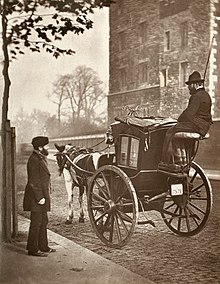This article needs additional citations for verification. (August 2010) |



The hansom cab is a kind of horse-drawn carriage designed and patented in 1834 by Joseph Hansom, an architect from York.[1]: 30 The vehicle was developed and tested by Hansom in Hinckley, Leicestershire, England.[2] Originally called the Hansom safety cab, it was designed to combine speed with safety, with a low centre of gravity for safe cornering. Hansom's original design was modified by John Chapman and several others to improve its practicability, but retained Hansom's name.[3][4]
Cab is a shortening of cabriolet, reflecting the design of the carriage. It replaced the hackney carriage as a vehicle for hire; with the introduction of clockwork mechanical taximeters to measure fares, the name became taxicab.
Hansom cabs enjoyed immense popularity as they were fast, light enough to be pulled by a single horse (making the journey cheaper than travelling in a larger four-wheel coach) and were agile enough to steer around horse-drawn vehicles in the notorious traffic jams of nineteenth-century London. There were up to 7500 hansom cabs in use at the height of their popularity and they quickly spread to other cities in the United Kingdom (including Ireland), as well as continental European cities, particularly Paris, Berlin, and St Petersburg. The cab was introduced to other British Empire cities and to the United States during the late 19th century, being most commonly used in New York City.
- ^ Cite error: The named reference
dictionarywas invoked but never defined (see the help page). - ^ "The Hansom Cab was designed, patented and tested in Hinckley". Hinckley Past & Present. Archived from the original on May 24, 2022. Retrieved July 26, 2017.
- ^ Harris, Penelope (2010). The Architectural Achievement of Joseph Aloysius Hansom (1803-1882), Designer of the Hansom Cab, Birmingham Town Hall, and Churches of the Catholic Revival. Edwin Mellen Press. pp. 86–91, 93. ISBN 9780773438514. OL 24585797M.
- ^ "The life of Joseph Aloysius Hansom (1803-1882)". Hinckley Past & Present. Archived from the original on April 17, 2022. Retrieved July 26, 2017.